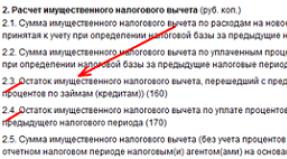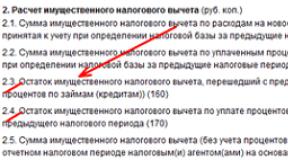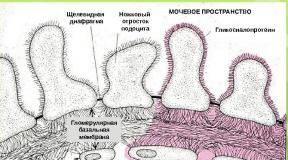The main symptom of a coma. Causes, symptoms, diagnosis and treatment of comatose states. Principles of treatment for coma
The main causes of coma are lesions of the central nervous system, which can be organic, with a violation of the structure of the brain, or functional. Occurs due to injuries, metabolic disorders, shock, and failure of vital organs. A coma is a pathological condition that is manifested by loss of consciousness of varying degrees of severity, up to the absence of bioelectrical activity of the brain, which can be fatal.
Causes of comatose states
Coma develops when the central nervous system, i.e. the brain, fails. This is caused by various types of intoxication (endogenous and exogenous), traumatic brain injury, sepsis, and acute vascular insufficiency (shock). The causes of coma can be related directly to the brain, and sometimes are a consequence of failure of vital organs: heart, liver, kidneys, lungs.
The main causes of comatose states:
- Uremia (accumulation of nitrogenous wastes in the blood) due to renal failure.
- Hyperammonemia in liver failure.
- Ketoacidosis.
- Hypoglycemia.
- Traumatic brain injuries, brain tumors.
- Inflammatory diseases of the central nervous system: encephalitis,.
- Impaired cerebral circulation in ischemic, hemorrhagic stroke.
- Prolonged hypoxia with shock, suffocation, acute respiratory failure.
Endogenous and exogenous intoxication
Endogenous intoxications often lead to a coma, the causes of which are the failure of organs performing the detoxification function. With hepatic coma, toxic products accumulate in the blood (cadaverine, putrescine, phenols, mercaptans, ammonia), which are formed in the intestines.
Under normal conditions, the liver binds toxins and converts them into a soluble state, in which they are excreted in the urine. In cirrhosis and acute hepatitis, toxic substances coming from the digestive tract through the portal vein are not neutralized and circulate in the bloodstream. At the same time, a sweet liver odor emanates from the patient. Endogenous poisons enter the brain through the blood-brain barrier, causing inhibition of the cortex, which leads to loss of consciousness (coma).
 Uremic coma is caused by renal failure due to glomerulonephritis, dehydration, porphyria and other pathological conditions. Products of nitrogen metabolism (creatinine, urea, ammonia) accumulate in the blood. Patients with uremic coma exhibit symptoms such as:
Uremic coma is caused by renal failure due to glomerulonephritis, dehydration, porphyria and other pathological conditions. Products of nitrogen metabolism (creatinine, urea, ammonia) accumulate in the blood. Patients with uremic coma exhibit symptoms such as:
- smell of urine;
- scratching on the skin;
- powdered with uric acid crystals (with uremia, waste products are released through the skin)
- irritation and inflammation of the mucous membranes of the gastrointestinal tract;
- vomit.
Toxic compounds penetrate well through the brain barrier and cause inhibition of the cerebral cortex, which leads to a coma.
Ketoacidosis occurs in both types of diabetes mellitus. Glucose does not pass into the cells, which leads to a switching of metabolism from carbohydrate to fat. Fatty acids are oxidized, forming ketone bodies, which are toxic to the nervous system. They lead to inhibition of the cerebral cortex, dysfunction of the respiratory center (the patient develops Cheyne-Stokes breathing). Acetonemic vomiting is one of the symptoms of ketoacidotic coma. If you lose consciousness, vomit may enter the bronchi and cause pneumonia.
Poisoning with organophosphorus substances, heavy metals, pesticides, and herbicides can lead to damage to the brain and detoxification organs: liver and kidneys.
Hypoxia
The brain is sensitive to lack of oxygen. Therefore, hypoxia leads to coma. The causes of hypoxia are associated with severe anemia, shock, and respiratory failure. This results in excessive blood loss (hemorrhagic shock) and hypovolemia (loss of fluid).
Brain damage
A comatose state can be caused directly by brain damage, which occurs as a result of such diseases:
- meningitis;
- encephalitis;
- injuries;
- tumors.
Inflammation of the brain and its membranes occurs during sepsis (blood poisoning), as well as meningococcal infection, infection with a virus.
Hemorrhagic and ischemic stroke lead to coma and failure of brain function. Ischemic stroke often occurs due to arterial thrombosis. The cause of hemorrhagic stroke usually lies in increased blood pressure and fragility of blood vessels.
Diagnosis and treatment
The severity of the patient's condition and the depth of the coma are assessed by a general practitioner, neurologist or resuscitator. Reflexes (eye, tendon), skin sensitivity, and reaction to pain are checked. An ultrasound or CT scan is performed. The gold standard is MRI to exclude organic brain lesions such as trauma, stroke, tumors.
Diagnosis of comatose states includes a general blood and urine test. Based on symptoms, a biochemical blood test is prescribed for ketone bodies, liver enzymes, bilirubin, urea, and creatinine. If meningitis or encephalitis is suspected, a diagnostic spinal function is performed.
In comatose states, resuscitation of the patient is carried out in the intensive care unit. Intensive therapy for comatose states includes hemodialysis, oxygenation, and other measures aimed at eliminating the cause. In a comatose state, treatment depends on the damaging factor:
- In case of uremic coma, blood dialysis is prescribed using an artificial kidney.
- Hepatic coma is treated with lactulose, which reduces the absorption of ammonia. The antibiotic Rifaximin is also prescribed, which inhibits putrefactive microflora and increases the activity of liver enzymes.
- If hypovolemia or shock develops, crystalloid and colloid solutions are infused intravenously.
Caring for a patient in a coma includes placing a urinary catheter, hygienic measures, preventing bedsores (using anti-decubitus mattresses), and turning the patient over. Since coma is life-threatening, patients are under constant strict supervision of medical personnel.
COMA
DEFINITION.
“Coma” is translated from ancient Greek as deep sleep. According to the classical definition, this term denotes the most significant degree of pathological inhibition of the central nervous system (CNS), characterized by a deep loss of consciousness, lack of reflexes to external stimuli and a disorder in the regulation of vital body functions.
However, due to the significance of this diagnosis for practice, the threat of this condition to life and the need for early treatment, in practice coma is also diagnosed with less pronounced depression of the central nervous system, if it is considered as a stage of its development. Therefore, it is more appropriate to determine to whom How:
a state of cerebral insufficiency, characterized by a violation of the coordinating activity of the central nervous system, dissociation of the body into separate, autonomously functioning systems, which at the level of the whole organism lose the ability to self-regulate and maintain homeostasis; clinically, coma is manifested by loss of consciousness, impairment of motor, sensory and somatic functions, including vital ones.
MAIN CAUSES OF APPEARANCE AND PATHOGENESIS.
Comatose states develop as a result of various causes, which can be grouped into four groups:
a) intracranial processes (vascular, inflammatory, volumetric, etc.);
b) hypoxic conditions during
Somatic pathology (respiratory hypoxia with damage to the respiratory system, circulatory hypoxia with circulatory disorders, hemic hypoxia with hemoglobin pathology),
Tissue respiration disorders (tissue hypoxia),
A drop in oxygen tension in the inhaled air (hypoxic hypoxia);
c) metabolic disorders (primarily of endocrine origin);
d) intoxication (both exo- and endogenous).
With all the diversity of the etiology of comatose states, their pathogenesis has much in common, and the factors that serve as the primary causes of some types of comas act as pathogenetic mechanisms in others. The direct mechanism of cerebral insufficiency is a violation of the formation, distribution and transmission of nerve impulses in brain cells due to depression of tissue respiration, metabolism and energy. This occurs due to a reduction in the delivery of oxygen and nutrients to the brain tissue (ischemia, venous congestion, microcirculation disorders, vascular stasis, perivascular edema), changes in acid-base and electrolyte balance, increased intracranial pressure, edema and swelling of the brain and meninges. The latter can lead to brain dislocation with mechanical damage to the tissue of vital centers. With any coma, at one stage or another, tissue hypoxia of varying severity develops. Disturbances of the acid-base state most often have the character of metabolic acidosis; with primary damage to the respiratory system, respiratory acidosis develops. Less commonly, for example, with persistent vomiting, metabolic alkalosis occurs, and hyperventilation leads to respiratory alkalosis. A combination of various metabolic and respiratory shifts is characteristic. Among electrolyte disturbances, the most significant are changes in potassium concentration (both hypo- and hyperkalemia) and hyponatremia. The latter plays an important role in the increase in cerebral edema. Progressive metabolic disorders have a histotoxic effect. As the coma deepens, breathing problems develop, and subsequently blood circulation.
Classification.
Depending on the causative factors, there are “primary” And “secondary” coma (see Table 1).
To assess the prognosis and choose treatment tactics, it is very important to determine what led to the development of a coma: focal brain damage with mass effect, damage to the brain stem, or diffuse damage to the cortex and brain stem. Moreover, the first two options are characteristic of primary ones, and the last one occurs almost exclusively in secondary comas.
Turning off consciousness - stun- can have different depths, depending on which it is divided into:
obnibulation - fogging, stupefaction, “cloudy consciousness”, stunning,
doubtfulness - drowsiness,
stupor - unconsciousness, insensibility, pathological hibernation, deep stupor,
to whom - the most profound degree of cerebral insufficiency.
As a rule, instead of the first three options, a diagnosis of “precoma” is made.
In medicine, the signs of clear consciousness are considered to be the ability of a person to respond meaningfully and adequately to external stimuli while remaining intact and oriented in the surrounding environment (place, time) and in one’s own personality. Consciousness is assessed in terms of its content and its level of activation. Based on this, disorders of consciousness are conventionally divided into stupefaction, confusion and loss of consciousness. Darkness and confusion of consciousness (twilight state, delirium, oneiroid) are characterized by a violation of its content side, loss of clarity of thinking, while a common symptom of the syndromes of switching off (depression) of consciousness is a decrease in the level of its activation, i.e. decreased overall level of wakefulness. Depending on the degree of such a decrease, stupor, stupor, and coma are diagnosed.
Stun– partial switching off of consciousness, characterized by a violation of the level of attention, i.e. the ability to select the necessary information and produce coherent, logically consistent thoughts and actions in response. Verbal contact with the patient is preserved, however, an increase in the threshold of all external stimuli and a decrease in his own activity are noted: the patient opens his eyes in response to someone addressing him, answers simple questions and follows simple instructions; reacts to pain in a coordinated manner, but all his reactions are monosyllabic and slow. The patient cannot perform a task that requires sustained attention, for example, consistently subtracting from one hundred and seven.
Sopor– switching off of consciousness, characterized by the cessation of verbal contact while maintaining the reaction in the form of opening the eyes to strong external stimuli and the presence of a protective coordinated motor reaction to pain.
Coma– the most profound shutdown of consciousness, in which verbal contact with the patient is impossible, there is no opening of the eyes to afferent stimulation, and defensive reactions to painful stimuli are uncoordinated.
It is customary to distinguish three degrees of coma: mild, severe and deep.
Mild or grade 1 coma is characterized by the occurrence of general motor restlessness or withdrawal of a limb in response to a painful stimulus. Corneal reflexes and pupillary reactions to light are preserved, swallowing is not impaired, breathing and blood circulation are sufficient to maintain the vital functions of the body. Urination is not voluntary; Possible urinary retention.
Severe or second degree coma is determined by the complete absence of a motor response to sound and moderate painful stimuli and the presence of protective reflexes to strong painful stimuli. Pathological types of breathing, arterial hypotension and heart rhythm disturbances are observed. The pupils are often narrow, less often wide, their reactions to light and corneal reflexes are reduced. Swallowing is impaired, but when liquid enters the respiratory tract, coughing movements occur, indicating partial preservation of bulbar functions. Deep reflexes are depressed.
Deep or III degree - characterized by extinction of all, including vital reflex acts. Breathing is not adequate, cardiac activity is diminished. Motor reactions are not evoked, muscle hypotonia is determined. The central position of the eyeballs is observed, the pupils are wide, their reaction to light and corneal reflexes are absent.
Various scales are used for quantitative assessment; the most famous is the Glasgow scale (Table 1). The condition of patients is assessed at the time of admission and after 24 hours according to three parameters: opening of the eyes to sound or pain, verbal response to external stimuli, motor response to external stimuli.
SCALE OF DEPTH OF COMATOUS CONDITIONS
(Glasgow-Pittsburgh) .Table 1.
|
Nature of the reaction | ||
|
Opening your eyes |
Spontaneous opening In response to verbal instructions In response to painful stimulation Absent | |
|
Physical activity |
Goal-directed response to verbal instruction Purposeful response to stimulation (“withdrawal of the limb”) Purposeful response to painful stimulation (“withdrawal with flexion of the limb”) Pathological tonic flexion movements in response to painful stimulation Pathological tonic extension movements in response to painful stimulation Lack of motor response in response to painful stimulation | |
|
Verbal responses |
Maintaining orientation, quick correct answers Confused speech Some incomprehensible words, inadequate speech production Inarticulate sounds Lack of speech |
Note: to determine the degree of depression of consciousness, it is necessary to sum up the points that determine the state of each of the three proposed functions.
Compliance of characteristics according to the Glasgow scale with traditional criteria
However, there are no pathogenetically substantiated (which to a certain extent can be attributed to classifications of coma depth) and clearly defined clinical distinctions between the four degrees of stunning, and therefore, regardless of the degree of loss of consciousness, the use of the term is permissible coma , the depth of which can be assessed by a simple but informative
clinical scale (Table 1).
CLASSIFICATION OF COMAS DEPENDING ON THE CAUSES OF THEM
|
A. Primary |
B. Coma as a result of secondary damage to the central nervous system |
|
|
cerebral comas ("cerebral coma") |
a) endogenous factors |
b) external factors |
|
Cerebrovascular (as a result of ischemic or hemorrhagic stroke, subarachnoid hemorrhage), Epileptic, With intracranial space-occupying processes (tumors, echinococcosis, abscesses), In case of infectious damage to the brain tissue or meninges, Traumatic. |
In case of insufficiency of internal organ function (uremic, hepatic, hypoxic due to damage to the respiratory or circulatory system), For diseases of the endocrine system (diabetic, hypothyroid and thyrotoxic, hypocorticoid, etc.), For neoplasms (hypoglycemia with a hormonally active tumor of pancreatic β-cells or massive hormonally inactive malignant tumors), For other therapeutic, surgical, infectious and other diseases (malarial, pernicious anemic, etc.). |
In case of relative or absolute overdose of hypoglycemic drugs (hypoglycemic), During fasting (alimentary-dystrophic), In case of intoxication (alcohol, opiate, barbiturate, poisoning with tranquilizers, methanol, carbon monoxide, etc.), When overheated (hyperthermic or "heatstroke"), In case of hypothermia, In case of electrical injury, etc. |
POSSIBLE COMPLICATIONS.
Among the complications of coma that are important at the prehospital stage, we can roughly highlight:
conditions and syndromes associated directly with brain damage and swelling;
pathological conditions and reactions caused by a violation of the regulatory function of the central nervous system.
The first include such serious complications as:
various breathing disorders until it stops;
hemodynamic disorders, manifested by both arterial hyper- and hypotension, pulmonary edema, and cardiac arrest;
central hyperthermia.
The second, although they are “peripheral” in nature, can also be fatal:
vomiting with aspiration of vomit into the respiratory tract and the development of asphyxia or Mendelssohn syndrome (acute respiratory failure due to broncho-obstruction and subsequent toxic pulmonary edema when acidic gastric contents enter the respiratory system);
acute urinary retention (“neurogenic bladder”) with the possibility of bladder rupture;
ECG changes, which, unlike the “heart attack-stroke” syndrome, are in the nature of myocardial dystrophy - various changes in the T wave and ST segment, an increase in the amplitude of the U wave, prolongation of the electrical systole and QT interval; Sometimes infarction-like changes may appear.
CALL STRUCTURE “03”.
According to our data, obtained from analyzing the work of the Moscow Emergency Medical Service, the frequency of coma at the prehospital stage is 5.8 per 1000 calls. The most common cause of coma is stroke - 57.2%, drug overdose comes in second place - 14.5%, followed by hypoglycemic coma - 5.7%, traumatic brain injury - 3.1%, diabetic coma and poisoning medications - 2.5% each, alcoholic coma - 1.3%; Coma was most rarely diagnosed due to poisoning by various poisons - 0.6%; Quite often, the cause of coma at the prehospital stage remained not only unclear, but even unsuspected (coma of unknown origin) - 11.9%. At the same time, prehospital mortality reaches 4.4%.
What is a coma?
Coma called an unconscious state with a profound impairment of reflexes and lack of response to stimulation.
The general and main symptom of coma state of any origin is a deep loss of consciousness caused by damage to vital parts of the brain.
What is the pathogenesis of comatose states?
In the pathogenesis of comatose states, circulatory disorders in the brain and toxic damage to cells of the central nervous system are of primary importance. More often comatose state observed in acute cerebrovascular accidents, diabetes mellitus, chronic nephritis, increasing liver failure, severe poisoning.
What are the symptoms of precoma?
Coma can occur suddenly in the midst of relative well-being. Acute development is typical for cerebral coma during stroke, hypoglycemic coma. However, in many cases, a coma, complicating the course of the disease, develops gradually (with diabetic, uremic, hepatic coma and many other comatose states). In these cases, coma, a deep loss of consciousness, is preceded by a precoma stage. Against the background of an increasing exacerbation of the symptoms of the underlying disease, signs of damage to the central nervous system appear in the form of stupor, lethargy, indifference, confusion with periodic clearings. However, during this period, patients retain the ability to respond to strong irritations, belatedly, in monosyllables, but still answer a loudly asked question; they retain pupillary, corneal and swallowing reflexes. Knowing the symptoms of precomatosis state It is especially important, since often timely provision of assistance during this period of illness prevents the development of coma and saves the life of the patient.
What are the distinctive features state skin of a patient with comas of various etiologies?
When examining the skin, it should be taken into account that with uremia, thrombosis of cerebral vessels, and anemia, the skin is pale. In alcoholic coma or cerebral hemorrhage, the face is usually hyperemic. Pink coloration of the skin is characteristic of coma due to carbon monoxide poisoning. Yellowness of the skin is usually observed in hepatic coma. Determining the moisture content of the skin of a patient in a coma is important. Moist, sweaty skin is characteristic of a hypoglycemic coma. In diabetic coma, the skin is always dry. Traces of old scratching on the skin can be noted in patients with diabetic, hepatic and uremic coma. Fresh boils, as well as skin scars from old boils found in comatose patients, suggest diabetes mellitus.
The study of skin turgor is of particular importance. In some diseases accompanied by dehydration of the body and leading to the development of coma, there is a significant decrease in skin turgor. This symptom is especially pronounced in diabetic coma. A similar decrease in the turgor of the eyeballs in diabetic coma makes them soft, which is easily determined by palpation.
What are the distinctive features of the mucous membranes in comas of different etiologies?
When examining the mucous membranes, you should pay attention to color and degree of moisture. Jaundice of the sclera is usually detected in hepatic coma and anemia. When examining the tongue, the presence of fresh bites and scars from old bites should be suggestive of epilepsy. Uremic coma is characterized by unusual dryness of the tongue. Severe swelling of the subcutaneous tissue can be detected in patients with uremic and hepatic coma. In the latter case, edema is combined with ascites.
What are the features of a patient’s breathing in various types of coma?
For the comatose state characterized by a violation of the breathing rhythm. Large noisy Kussmaul breathing is often observed in diabetic and hepatic coma. With a cerebral coma, snoring breathing usually appears. Often, in patients in a coma, Cheyne-Stokes breathing is observed with a gradual increase and then weakening of the depth of respiratory movements until a pause in respiratory movements appears (apnea period).
Determining the smell of the air exhaled by a patient has important diagnostic value. Uremic coma is characterized by the smell of ammonia, sometimes so strong that it is detected already upon entering the room where the patient is lying. In diabetic coma, the smell of acetone is almost always detected in the exhaled air, reminiscent of the smell of slightly ripe apples.
What are the features state cardiovascular system in comas of various etiologies?
The study of pulse and blood pressure in patients in a coma is of great importance. Bradycardia with pulse tension and high blood pressure is observed in eclampsia and in the initial stages of cerebral coma. High arterial hypertension is usually detected in patients with uremic coma. In diabetic coma, low blood pressure and tachycardia are detected. The detection of severe neurological symptoms in the form of hemiplegia or hemiparesis indicates an acute cerebrovascular accident as the cause of coma.
How is care provided to a patient with a diabetic coma?
Treatment of coma depends on the nature of the underlying disease. In a diabetic coma, the patient is administered insulin subcutaneously and intravenously, sodium bicarbonate, and saline as prescribed by the doctor.
How is care provided to a patient with hypoglycemic coma?
Hypoglycemic coma is preceded by a feeling of hunger, weakness and trembling throughout the body. Before the doctor arrives, the patient is given sugar or sweet tea. 20-40 ml of 40% glucose solution is injected into a vein.
How is emergency care provided to a patient with uremic coma?
In uremic coma, therapeutic measures are aimed at reducing intoxication. For this purpose, the stomach is washed, a cleansing enema is given, an isotonic sodium chloride solution and a 5% glucose solution are injected dripwise.
How is emergency care provided to a patient with hepatic coma?
In case of hepatic coma, glucose solutions, steroid hormones, and vitamins are administered dropwise as prescribed by the doctor.
Comatose states that occur as a result of various pathological processes can be divided into the following groups.
Caused by primary damage to the central nervous system (neurogenic). This group includes coma that develops with strokes, traumatic brain injury, epilepsy, inflammation and tumors of the brain and its membranes.
Developing due to gas exchange disorders.
† Hypoxic. Associated with insufficient oxygen supply from the outside (suffocation) or impaired oxygen transport in severe acute circulatory disorders and anemia.
† Respiratory. Caused by hypoxia, hypercapnia and acidosis due to significant disturbances in pulmonary gas exchange during respiratory failure.
Caused by metabolic disorders due to insufficient or excessive production of hormones (diabetic, hypothyroid, hypocorticoid, hypopituitary coma), overdose of hormonal drugs (thyrotoxic, hypoglycemic coma).
Toxogenic comas associated with endogenous intoxication due to toxic infections, liver and kidney failure (hepatic, uremic coma), pancreatitis or with exposure to exogenous poisons (coma due to poisoning, including alcohol, FOS, etc.).
Primary caused by the loss of water, electrolytes and energy substances (hyponatremic coma with the syndrome of inadequate ADH production, chlorhydropenic coma, developing in patients with persistent vomiting, nutritional-dystrophic, or hungry coma).
Impaired consciousness
The degree of impairment of consciousness often plays a decisive role in the outcome of many diseases and pathological processes. Therefore, determining the state of consciousness is one of the main points when examining a patient, especially in emergency situations. Disturbances (disorders) of consciousness are listed in Fig. 20–12
Rice. 20–12. Main types of disorders of consciousness.
Disturbances of consciousness are usually divided into changes in consciousness and depression of consciousness.
Changes in consciousness- productive forms of disturbance of consciousness that develop against the background of wakefulness. They are characterized by a disorder of mental functions, a distorted perception of the environment and one’s own personality, and are usually not accompanied by immobility. These include delirium, amentia and twilight disorders of consciousness. They are the leading manifestations of most mental illnesses and are considered in psychiatry.
Oppression of consciousness- unproductive forms of impairment of consciousness, characterized by a deficit of mental activity with a decrease in the level of wakefulness, a distinct depression of intellectual functions and motor activity.
To determine the degree of depression of consciousness, the so-called scale has proven itself well Glasgow(Scottish scale, see the article “Scale” in the Appendix “Reference of Terms” on the CD). The degree of depression of consciousness is assessed in points.
Certain types of consciousness disorders
Stun is the result of an increase (under the influence of a pathogenic factor) of the threshold of excitability. In this regard, stunning is characterized by a decrease in the body's sensitivity to external stimuli.
Manifestations
When stunned, the following is noted:
† Maintaining consciousness against the background of varying degrees of disruption of consistency, logic and clarity of thinking (confusion).
† Physical inactivity.
† Disorientation in the situation.
† Increased drowsiness (doubtfulness). Strong stimuli (sound, light, pain) only temporarily remove the patient from the state of stunning.
A state of stupor often precedes stupor.
Sopor- a condition characterized by general inhibition of mental activity, significant depression of consciousness (but not its complete loss! [unlike coma]), loss of voluntary movements, while maintaining reflexes (unlike coma) to strong sound, light and pain stimuli. The latter is usually expressed by short-term motor reactions, groaning, and movement of facial muscles.
Stupor is often considered a stage in the development of coma, preceding loss of consciousness (i.e., the development of coma itself).
Delirium characterized by:
† false affective perception of the environment and events, one’s own role in them (illusions),
† spontaneous endogenous visual and/or auditory sensations (hallucinations),
† speech and motor stimulation.
In a state of delirium, the patient actively participates in the events he senses (he can attack, defend himself, escape; vividly describe the images “visible” to him, “conducts a conversation” with an absent interlocutor).
Amentia characterized by:
† incoherence (discontinuity) of thinking,
† violation of orientation, perception of surrounding objects, events and one’s own personality;
† chaotic, disorderly excitement;
† non-purposeful motor activity.
† In case of recovery, the patient does not remember (amnesia) what happened to him during the period of amentia.
Twilight state consciousness is characterized by:
† violation of orientation in the environment,
† detachment from current real events,
† behavior based on hallucinations (usually frightening in nature),
† sudden onset and cessation,
† often committing aggressive acts.
† Episode of twilight state is amnesic.
It is necessary to distinguish stupor from various types of impairment and loss of consciousness. During stupor, consciousness is not lost. Stupor is a condition characterized by complete immobility, weakening or absence of reactions to external sound, light and pain stimuli against the background of preserved consciousness.
Stupor often develops in patients with mental (for example, schizophrenia), as well as severe somatic (for example, with severe malabsorption syndrome) diseases. Stupor is also observed in a number of depressive states (for example, after the loss of a loved one) and severe psychogenic trauma that develops under the influence of various extreme factors.
COMA (Greek koma - deep sleep) is a general extremely serious condition of the body.
Occurs as a result of the action of exo- and endogenous damaging factors.
Characterized by loss of consciousness
insufficiency of functions of organs and physiological systems of the body.
CAUSES OF COMA
Who is caused by various factors. They are usually divided into exogenous and endogenous. The latter can be infectious or non-infectious.
Exogenous factors
Exogenous factors (Fig. 20–13) are pathogenic environmental agents, usually of extreme strength, toxicity and/or destructive nature.

Rice. 20–13. The most common exogenous causes of coma.
Various traumatic (usually the brain) factors (electric current, mechanical head trauma).
Thermal effects (overheating, sunstroke, hypothermia).
Significant fluctuations in barometric pressure (hypo- and hyperbaria).
Neurotropic toxins (alcohol and its surrogates, ethylene glycol, toxic doses of drugs, sedatives, barbiturates and some other drugs).
Infectious agents (neurotropic viruses, botulinum and tetanus toxins, pathogens of malaria, typhoid fever, cholera).
Exogenous hypoxia and anoxia.
Radiation energy (large doses of penetrating radiation).
Endogenous factors
Endogenous factors (Fig. 20–14), leading to the development of coma, are the result of severe disorders of the body’s vital functions. They are observed during the unfavorable course of various diseases and painful conditions. These conditions lead to significant deviations from the norm of vital parameters and constants, excess or deficiency of metabolic substrates and/or oxygen in the body.

Rice. 20–14. The most common endogenous causes of coma.
Pathological processes in the brain (ischemia, stroke, tumor, abscess, edema, etc.).
Circulatory failure (cerebral hypoxia).
Respiratory failure (brain hypoxia with status asthmaticus, asphyxia, pulmonary edema).
Pathology of the blood system (massive hemolysis of red blood cells, severe anemia).
Endocrinopathies (hypoinsulinism, hypo- and hyperthyroid conditions, adrenal insufficiency).
Liver failure, digestive system disorders (malabsorption syndrome, intestinal autointoxication and/or autoinfection).
Kidney failure.
Comatose states develop in some cases with a severe progressive course of collapse and shock.
General pathogenesis and manifestations
The pathogenesis of comatose states, regardless of the causes that caused them, includes several common key links shown in Fig. 20–15.
Rice. 20–15. The main links in the pathogenesis of comatose states.
General manifestations of comatose states are presented in table. 20–5.
Table 20–5. General manifestations of comatose states
|
Organs and their systems |
Changed functions |
|
Nervous and endocrine |
Disorders of consciousness, loss of consciousness, hypo‑ and areflexia, imbalance of biologically active substances and their effects. |
|
Heart failure, arterial hypotension and collapse, redistribution of blood flow, capillary trophic insufficiency, |
|
|
Respiratory failure. |
|
|
Blood and hemostasis system |
Depositing blood change in blood viscosity, thrombohemorrhagic syndrome. |
|
Liver failure. |
|
|
Kidney failure. |
|
|
Digestion |
Insufficiency of cavity and membrane digestion, intestinal autointoxication, autoinfection. |
Hypoxia and disturbances in energy supply processes
The disruption of oxygen supply to tissues and organs is either the cause of coma and/or its pathogenetic link. The observed violation of the substrate supply of cells causes insufficiency of biological oxidation in them.
ATP resynthesis in brain neurons is ensured mainly due to the energy of glucose oxidation in tissue respiration reactions. Neurons of the brain, which are normally the most oxygen-dependent structures, under hypoxic conditions become the most vulnerable object in the body.
† The brain mass, which is about 2% of body mass, accounts for approximately 20% (!) of cardiac blood output. In this regard, a decrease in the delivery of oxygen and/or metabolic substrates to the brain through the blood eliminates the possibility of its normal functioning.
† Cessation of cerebral circulation within 8–10 s leads to a critical oxygen deficiency and disturbances in the energy supply of neurons. The result is loss of consciousness.
† The depletion of glucose that occurs over the next 4–7 minutes, as well as the suppression (due to increasing acidosis) of anaerobic metabolism is accompanied by irreplaceable consumption of ATP energy. In this regard, the specific activity of neurons is inhibited, consciousness is lost, and rapidly progressing degenerative processes begin to develop.
† The breakdown of large-molecular organic compounds in neurons, as well as the accumulation of excess Na + and some other ions in them, leads to a significant increase in intracellular osmotic and oncotic pressure. This in turn leads to hyperhydration of nerve cells, combined with the release of fluid from the vessels into the interstitium (i.e., cerebral edema), venous hyperemia and hemorrhages into the brain substance.
Brain neurons are more damaged under conditions of ischemia than hypoxemia. With normal perfusion pressure in the vessels of the brain, even with a decrease in p a O 2 to 30 mm Hg. and below, there are no signs of neuronal destruction.
Violation of the energy supply of cells ultimately causes their dysfunction, the development of dystrophy and the disorder of plastic processes in them. This is most pronounced in the brain and heart. In this regard, in patients in a coma, consciousness is lost, reflexes are reduced or absent; arrhythmias and insufficiency of cardiac contractile function develop, as well as arterial hypotension; the frequency and periodicity of the neurons of the respiratory center is disrupted, the volume of alveolar ventilation decreases, which leads to respiratory failure and worsening hypoxia.
Intoxication
Coma of any origin is characterized by the accumulation of toxic substances in the body. They enter the body from the outside (with comas of exogenous origin) and are formed within it (with endogenous comas). A number of comatose states are caused by neurotropic toxins, alcohol and its surrogates, ethylene glycol, fungal toxins; Medicines when used incorrectly (for example, drugs, barbiturates, tranquilizers).
Toxic substances, as well as the products of their metabolism, have the greatest pathogenic effect on the neurons of the brain stem and cerebral hemispheres, endocrine glands, heart, liver, kidneys, and blood cells. Toxins damage membrane structures and enzymes of cells. In this regard, the function of neurons in cortical and subcortical structures is suppressed. This, in turn, leads to disruptions in the activity of the cardiovascular system, respiratory, endocrine and digestive systems, kidneys, liver, blood systems, hemostasis, etc.
Intoxication of the body with metabolic products is aggravated by disruption of the detoxification function of the liver and excretory activity of the kidneys. Thus, during a diabetic coma, the levels of CT, lactic and pyruvic acids in the blood increase significantly. In this case, for example, an excess of acetoacetic acid significantly suppresses the activity of neurons in the brain and autonomic ganglia.
During hepatic coma in the blood, the content of putrescine, cadaverine, phenol derivatives, indole, skatole (formed in the large intestine during the breakdown of protein), ammonium compounds (ammonium carbonate and carbamic acid, ammonium hydroxide) increases significantly. An important pathogenetic link in comatose states is the accumulation of excess ammonia ( which inhibits Na-K-ATPase, forms toxic metabolites, damages benzodiazepine receptors, and has other pathogenic effects). Normally, the above compounds are inactivated in the liver and excreted from the body by the kidneys. However, in case of liver and/or kidney failure, these toxic compounds and their derivatives potentiate damage to the brain and other organs, aggravating the patient’s condition.
CSR disorders
Deviation of ASR indicators is a natural phenomenon in coma of any origin.
In most cases, acidosis develops.
† Hypoxia of circulatory, respiratory, hemic and tissue types.
† Impaired renal function (inhibition of acidogenesis and ammoniagenesis, decreased excretory function).
† Liver dysfunction (suppression of the CT inactivation process). This increases the degree of acidosis.
Much less often and, as a rule, the development of alkalosis is recorded temporarily (for example, during a period of hyperventilation of the lungs or during hepatic coma, accompanied by a significant increase in the content of ammonium ions in the blood).
Imbalance of ions and water
Manifestations: Cell loss of K+. Development of hyperkalemia. Increase in cells. Increased intracellular . Hyponatremia. These changes are a consequence of decreased activity of Na + ,K + ‑ATPase of the plasmalemma and damage to cell membranes. Reduction and/or Some types of coma (for example, renal or hepatic) are characterized by other changes in the ion balance. These variants of comatose states may be accompanied by an increase in the level of aldosterone in the blood (due to its increased synthesis in the adrenal glands or decreased inactivation in the liver), causing reabsorption of Na + and excretion of K + in the kidney tubules with the development of hypernatremia and hypokalemia, respectively. Hyperosmia and hyperonkia. They are the result of the hydrolysis of large molecular compounds (LP, proteoglycans, glycogen and others) to medium and small molecules (proteins, amino acids, glucose, LA).
Consequences: Overhydration of brain cells and other organs (in hyperosmolar diabetic coma, on the contrary, hypohydration of cells develops, potentiating their damage). Increased fluid content in the intercellular space. An increase in the volume of fluid in the vascular bed (hypervolemia). Edema of the brain and lungs. Diarrhea, vomiting, polyuria (for example, in hypochloremic, diabetic, hyperosmolar coma). They can cause progressive extracellular and then total hypohydration. Significant increase in blood viscosity. Violation of organ-tissue and microhemocirculation. Disseminated aggregation of blood cells, its hypercoagulation and thrombosis (DIC syndrome).
Electrogenesis disorders
Manifestations
The disruption of the processes of energy supply to cells, damage to their membranes and enzymes during coma naturally causes disturbances: the formation of MP and PD. excitability (decrease, increase). carrying out excitation. This is most manifested in the structures of the brain and heart.
Consequences: Impaired consciousness, even loss of consciousness. Disorders of the functions of nerve centers (primarily respiratory and cardiovasomotor). Development of cardiac arrhythmias, including ventricular fibrillation.
Imbalance of biologically active substances and their effects
Manifestations: Impaired synthesis and release of biologically active substances of various classes by cells: neurotransmitters, hormones, cytokines, etc. Disruption of the processes of activation, inactivation, and delivery of biologically active substances to target cells. Violation of the interaction of biologically active substances with their cellular receptors. Target cell response disorder. The latter is caused by damage to cell membranes and intracellular mediators of the effects of hormones, mediators and cytokines. Disintegration of physiological and functional systems. Minimizing the functions of organs and tissues, energy consumption and plastic processes. Transition to the so-called metabolic regulation of organ and tissue functions. This usually precedes the development of a terminal condition.
Features of the pathogenesis of some comatose states
The specifics of individual types of coma are usually revealed in the early stages of its development. At these stages, the features of the cause of coma, as well as the initial links of its pathogenesis, still appear. As the severity of comatose states increases, their specificity decreases and their common features become more and more apparent.
Traumatic coma
Cause: injury accompanied by severe concussion and loss of consciousness. Unconsciousness during a traumatic coma can last from several minutes to a day or more.
Manifestations: Motor responses and eye opening to a painful stimulus are absent or significantly reduced. There is no speech or the patient makes inarticulate sounds. Hypo‑or areflexia. Breathing and heart rhythm are disrupted. Blood pressure and blood volume are reduced, even if there was no blood loss. † Involuntary urination. In connection with brain contusion, focal hemorrhages in it and edema, neuropathological signs are revealed: paralysis (usually hemiparesis), pathological reflexes, local sensitivity disorders, convulsions. Blood is usually found in the cerebrospinal fluid. When the bones of the base of the skull are fractured, specific signs appear: † symptoms of damage to neurons of the nuclei of the VII and VIII pairs of cranial nerves, † bruising in the orbital area (symptom of “glasses”),
bleeding and leakage of cerebrospinal fluid from the ear canals, nose, mouth.
Apoplectic coma
Risk factors: Arterial hypertension (especially periods of hypertensive crises). Atherosclerotic changes in the walls of cerebral vessels.
Pathogenesis
The leading pathogenetic factors of apoplexy coma are: ischemia and hypoxia of the brain (as a result of local or extensive circulatory disorders in it), a significant increase in the permeability of the walls of microvessels, and rapidly increasing edema of the brain substance. A stroke is characterized by secondary circulatory disorders around the area of cerebral ischemia with rapidly increasing signs of loss of sensitivity and movement.
Manifestations
In case of apoplexy coma as a result of cerebral hemorrhage: † the patient suddenly loses consciousness, † his face (in typical cases) is purple, † visible vessels are dilated and visibly pulsate, † pupils do not react to light, † tendon reflexes are reduced or absent (hyporeflexia), pathological reflexes are observed ( Babinsky and etc.), † due to damage and irritation of the brain substance, breathing disorders increase rapidly (it is noisy, hoarse), † hypertensive reactions and bradycardia are observed.
In apoplexy coma as a result of an ischemic stroke, the following are usually observed: † disorders of consciousness, up to its loss, † arterial hypotension, † bradycardia, † cardiac arrhythmias, † rare shallow breathing, † pale and cold skin and mucous membranes,
Consequences of cerebral hemorrhage or ischemic stroke. They are different and depend on: the scale and topography of the damage, the degree of hypoxia and cerebral edema, the number of lesions, the severity of arterial hypertension, the severity of atherosclerosis, and the patient’s age.
Apoplectic coma is one of the most unfavorable comatose states, fraught with death or disability of the patient.
Hypochloremic coma
Cause hypochloremic (chlorhydropenic, chloroprivic) coma - a significant loss of chlorine-containing substances by the body. This is observed with: prolonged repeated vomiting (in patients with endogenous intoxications, food poisoning, toxicosis of pregnancy, pyloric stenosis, intestinal obstruction); improper treatment with diuretics, long-term salt-free diet, renal failure at its polyuric stage, small intestinal fistulas. Considering that in the above conditions Cl – , Na + and K + are relatively slowly lost, as well as the compensating effects of adaptive mechanisms, coma develops in typical cases gradually.
Manifestations: Impaired formation of MP and AP due to a decrease in the content of Na +, K +, Cl – and some other ions in the blood plasma, intercellular and other biological fluids. Cell excitability disorders. Disturbances of specific and nonspecific cell functions. As a result of this, the following develop: † muscle weakness, † hypohydration. Due to the loss of fluid by the body: ‡ dry skin and mucous membranes, ‡ tissue turgor is reduced, ‡ facial features are sharpened, ‡ dry tongue ‡ oliguria develops ‡ Ht is significantly increased, ‡ Blood pressure is usually reduced ‡ BCC is reduced, ‡ ion imbalance, ‡ disruption of blood supply to the brain.
Cerebral ischemia, increasing in scale and degree, causes progressive disorders of consciousness: the state of stupefaction turns into psychomotor retardation and ends with loss of consciousness.
Treatment methods for comatose states
Etiotropic treatment is the main one. It largely determines the prognosis of the patient's condition. In this regard, measures are taken to stop or weaken the pathogenic effect of the causative factor.
† For traumatic coma:
‡ the damaging factor is eliminated,
‡ painkillers, local anesthetics,
‡ if necessary, anesthesia.
† For coma caused by intoxication of the body, use:
‡ specific antidotes,
‡ antitoxins,
‡ gastric lavage,
‡ diuretics.
† For diabetic comas:
‡ administer the calculated dose of insulin,
‡ if necessary, simultaneously with glucose solution (to prevent hypoglycemic coma).
† For coma of infectious origin: use antibacterial agents (antibiotics, sulfonamides, as well as antiseptics that act on the flora of the intestines and urinary tract).
Pathogenetic therapy is key in the treatment of any patient in a coma.
It includes measures aimed at blocking, eliminating and/or reducing the damaging effects of the main links in the pathogenesis of coma: hypoxia, intoxication, ACR disorders, ion and fluid imbalance, biologically active substances and their effects.
† Antihypoxic therapy
‡ Breathing gas mixtures with a high oxygen content.
‡ Hyperbaric oxygenation.
‡ Introduction of antioxidants (for example, glutathione, selenium, SOD, catalase, ubiquinone and others).
‡ Normalization of heart function and vascular tone.
† Elimination or reduction of the degree of intoxication of the body by:
‡ Blood transfusions, plasma and plasma substitutes, physiological sodium chloride solution.
‡ Introduction of solutions containing large-molecular organic compounds - polyglucin, reopopiglyukin and others. These drugs are combined with diuretics to stimulate the removal of fluid and toxic substances contained in it from the body.
‡ In severe cases, as well as in renal failure, uremic coma - hemodialysis and peritoneal dialysis.
† Normalization of ASR indicators, ion and liquid balance through:
‡ Controlled introduction into the body of buffer solutions with the required (for each patient this is selected individually, taking into account laboratory data) content and ratio of various ions.
‡ Blood transfusions, plasma, plasma substitutes.
† Normalization of the level of biologically active substances and their effects. For this purpose use:
‡ adrenal hormones (gluco- and mineralocorticoids, androgenic steroids, catecholamines),
‡ pancreatic hormones (insulin, glucagon),
‡ neurotransmitters (acetylcholine, norepinephrine), etc.
These drugs normalize the functions of the heart, kidneys, brain and other organs, homeostasis indicators, and activate specific and nonspecific adaptive reactions of the body.
Symptomatic therapy is aimed at optimizing the functions of organs and their systems, eliminating cramps, pain, and painful sensations in pre- and post-comatose states. For this purpose, use:
† anticonvulsants,
† painkillers (including narcotics),
† cardiotropic and vasoactive drugs,
† respiratory analeptics.
Considering that coma is characterized by severe disorders of the functions of organs, their systems, and regulatory mechanisms of the body, the effectiveness of therapeutic measures should be monitored by constant recording of the state of vital functions (cardiac activity, respiration, excretory function of the kidneys, etc.), consciousness and homeostasis parameters.
Coma called an unconscious state with a profound impairment of reflexes and lack of response to stimulation.
In the pathogenesis of comatose states, circulatory disorders in the brain and toxic damage to cells of the central nervous system are of primary importance.
Most often, comatose states are observed in acute cerebrovascular accidents, diabetes mellitus, chronic nephritis, increasing liver failure, and severe poisoning.
The general and main symptom of a coma of any origin is a deep loss of consciousness caused by damage to vital parts of the brain.
Coma may develop suddenly in the midst of relative well-being. Acute development is typical for cerebral coma during stroke, hypoglycemic coma.
However, in many cases, a coma, complicating the course of the disease, develops gradually (with diabetic, uremic, hepatic coma and many other comatose conditions).
In these cases, coma, a deep loss of consciousness, is preceded by a precoma stage. Against the background of an increasing exacerbation of the symptoms of the underlying disease, signs of damage to the central nervous system appear in the form of stupor, lethargy, indifference, confusion with periodic clearings.
However, during this period, patients retain the ability to respond to strong irritations, belatedly, in monosyllables, but still answer a loudly asked question; they retain pupillary, corneal and swallowing reflexes.
Knowledge of the symptoms of a precomatous state is especially important, since often timely provision of assistance during this period of the disease prevents the development of coma and saves the life of the patient.
When examining the skin, it should be taken into account that with uremia, thrombosis of cerebral vessels, and anemia, the skin is pale. In alcoholic coma or cerebral hemorrhage, the face is usually hyperemic. Pink coloration of the skin is characteristic of coma due to carbon monoxide poisoning. Yellowness of the skin is usually observed in hepatic coma.
Determining the moisture content of the skin of a patient in a coma is important. Moist, sweaty skin is characteristic of a hypoglycemic coma. In diabetic coma, the skin is always dry. Traces of old scratching on the skin can be noted in patients in diabetic, hepatic and uremic coma.
Fresh boils, as well as skin scars from old boils, found in patients in a coma, make one think about diabetes.
The study of skin turgor is of particular importance. In some diseases accompanied by dehydration of the body and leading to the development of coma, there is a significant decrease in skin turgor. This symptom is especially pronounced in diabetic coma.
A similar decrease in the turgor of the eyeballs in diabetic coma makes them soft, which is easily determined by palpation.
When examining the mucous membranes, you should pay attention to color and degree of moisture. Yellowness of the sclera is usually detected in hepatic coma and anemia.
When examining the tongue, the presence of fresh bites and scars from old bites should be suggestive of epilepsy. Uremic coma is characterized by unusual dryness of the tongue.
Severe swelling of the subcutaneous tissue can be detected in patients with uremic and hepatic coma. In the latter case, edema is combined with ascites.
A comatose state is characterized by a violation of the breathing rhythm. Large noisy Kussmaul breathing is often observed in diabetic and hepatic coma. With cerebral coma, snoring (stertorous) breathing usually appears. Often, in patients in a coma, Cheyne-Stokes breathing is observed with a gradual increase and then weakening of the depth of respiratory movements, until a pause in respiratory movements appears (apnea period).
Determining the smell of the air exhaled by a patient has important diagnostic value. Uremic coma is characterized by the smell of ammonia, sometimes so strong that it attracts attention already upon entering the room where the patient is lying.
If you smell alcohol or vodka fumes from your mouth, you should not exclude the alcoholic origin of the coma. In diabetic coma, the smell of acetone is almost always detected in the exhaled air, reminiscent of the smell of slightly ripe apples.
The study of pulse and blood pressure in patients in a coma is of great importance. Bradycardia with pulse tension and high blood pressure is observed in eclampsia and in the initial stages of cerebral coma.
High arterial hypertension is usually detected in patients in uremic coma. In diabetic coma, low blood pressure and tachycardia are detected.
The detection of severe neurological symptoms in the form of hemiplegia or hemiparesis indicates an acute cerebrovascular accident as the cause of coma.
In every case of coma, a doctor must be immediately called to the patient.
Treatment of coma depends on the nature of the underlying disease.
In diabetic coma The patient is administered subcutaneous and intravenous insulin, sodium bicarbonate, and saline solution as prescribed by the doctor.
Hypoglycemic coma preceded by a feeling of hunger, weakness and trembling throughout the body. Before the doctor arrives, the patient is given sugar or sweet tea. 20-40 ml of a 40% glucose solution is injected into a vein.
With uremic coma therapeutic measures are aimed at reducing intoxication. For this purpose, a cleansing enema is given, an isotonic sodium chloride solution and a 5% glucose solution are injected dripwise.
With hepatic coma As prescribed by the doctor, glucose solutions, steroid hormones, and vitamins are administered by drip.


















